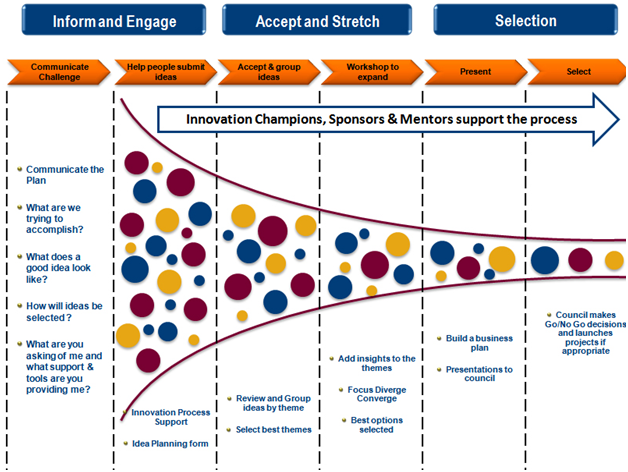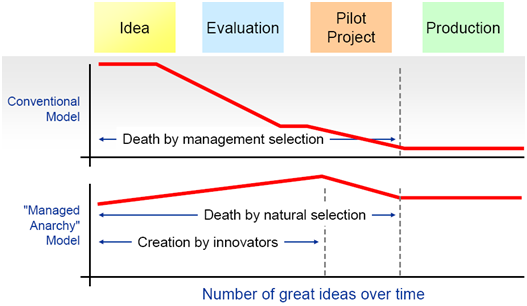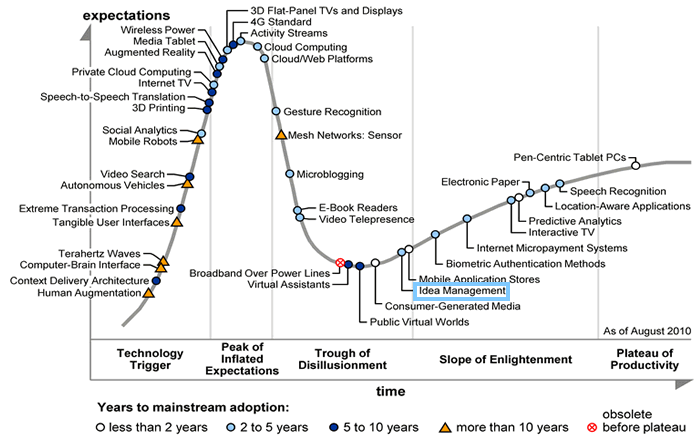Research by Ed Wolf – July 2011
![]() Building a Culture of Innovation
Building a Culture of Innovation
Summary
Gartner defines innovation as the successful realization of novel ideas that create value for an organization. Successful innovation requires a culture of collaboration, an investment of senior leadership, nurturing, participation, PR, and oversight. Technology can play an important role in the process, but without the other ingredients, the meal would not be complete.
I will try to provide a glimpse into what I have learned surrounding innovation from my research, including Gartner, IBM and vendor interviews.
Primary Objectives
Earlier this year I was charged with a project to research collaboration platforms. The scope was to investigate ways for employees to submit their ideas for new products and processes, to encourage innovation throughout the company. This process is commonly referred to as “ideation”.
The goals were to identify a platform that would:
- Allow employees to describe and submit ideas.
- Allow employees to review, comment on and refine submitted ideas (crowdsourcing).
- Nurture the best idea opportunities while filtering out the mediocre ones.
- Acknowledge an employee for their contributions and participation.
- Allow employees to follow their idea throughout the process.
- Easy to use and engaging for employees and innovation team alike.
What is an Ideation Platform?
Ideation platforms are sometimes referred to as ‘virtual suggestion boxes’, these platforms can become a valuable business tool which engage employees and foster innovation throughout the company.
The typical ideation process can be broken into three primary types:
- Open Ideation: Allowing for employees to submit a broad range of ideas, across many different categories.
- Campaigns: These are topic based idea channels which allow the business to focus on generating ideas for a specific problem. These are usually time limited and allow for targeted ideas to be rapidly generated. For example, at a Quarterly Management Meeting, a 2 week campaign can be created to generate ideas for reducing operation overhead by the end of Q3.
- Process Driven: A product’s or service’s development lifecycle requires that ideas be generated from post-mortem meetings, customer feedback, and internal employee feedback.
Figure 1 – Typical Innovation Funnel
A major concept within the ideation process is the Innovation Funnel (Figure 1) shows how an idea can materialize into a new service or product through a managed process. In an ideal environment, innovation champions (catalysts), business sponsors and managers help move and refine the ideas through the process. The funnel acts as mechanism in which the best ideas are fully vetted and brought to market at the end of the process.
Research Approach
IBM Global Innovation meeting
IBM has a workforce of over 400,000; of which 50% are mobile and not in a single office location. I looked to IBM to learn how they manage innovation on a global scale, and learned that innovation at the company is a top priority and engrained into the fabric of the organization. There are positions within the company that solely focus on fostering innovation throughout the different business units.
IBM also engages their employees to participate in open ideation as well as monthly ‘Idea Jams’ (campaigns). By giving employees access to ideas throughout the company, they have eliminated the silo approach to developing solutions for their customer. Everyone can provide input into new products and even download pre-release of the software they create before it’s released to the general public.
IBM has capitalized on the changes in their workforce (Table 1). Each generation brings its own strengths to the business. IBM has made use of the innovative spirit of the millennial generation while utilizing the experience of older employees. Everyone at the company has a role in the innovation process, regardless of their age.
Table 1 – Generational shifts unleash different work styles
In addition to benefiting from generational differences, IBM has evolved the way it manages ideation. Figure 2 shows that in a conventional ideation model, significant effort and resources are exerted before a production-grade product is ready to be released. In the ‘Managed Anarchy’ model, used by IBM, ideas are organically refined by employees resulting in more ideas reaching the production phase of the lifecycle.
Figure 2 – Idea Management Models
How Gartner Sees Ideation
Utilizing reports from Gartner, I was able to identify industry leaders and best practices. Gartner’s research is distinguished by Hype Cycles; a graphic representation of the maturity, adoption and social application of specific technologies. The cycle for emerging technologies (Figure 3) shows that mainstream adoption of idea management platforms are anywhere between 2 to 5 years away. Furthermore, Gartner indicates that expectations for the technology are moderate since these types of products are just now maturing and adding measurable business value.
Figure 3- Hype Cycle for Emerging Technologies, 2010
Gartner’s key findings on idea management show that:
- Innovation is supported by a wide range of processes including ideation, collaborative and open innovation.
- Innovation management technology supports early stage activities, such as idea generation, evaluation and selection, as well as later stage activities such as innovation portfolio management.
- There is little difference in basic features offered by vendors, but some important differences exist in geographic and industry focus, and compatibility with other platforms.
Gartner has gone on the record to state that choosing technology to support innovation is the last step in developing a better innovation management capability. Before selecting any technology, they recommend determining program goals and defining processes for idea collection, evaluation and selection. It was also advised that use cases, or scenarios that describe how you want processes to work, be utilized when choosing innovation management vendors rather than relying solely on checklists to gather requirements.
Vetting Vendors
Upon reviewing Gartner’s research, eleven vendors were invited to demo their products via a one-hour WebEx session. A Vendor Evaluation Checklist (see Appendix) was created in order to ask key questions to all of the vendors.
Each product was evaluated on a number of criteria including:
- Compatibility with Mac & PC
- Integration with Microsoft SharePoint
- Support for Single Sign-on and SAML
- Browser Independence
- Pricing
- User interface & experience
- Feature set & functionality
- Company history & clientele
- Underlying technology stack
- Product rollout time
The evaluation (Figure 4) was then utilized to rank each product between 1 and 100. This ranking is what ultimately helped to identify the top ideation platforms.
Key Findings
During the research and evaluation phase, I heard key themes, including the need for a culture that would accept innovation, that management had full support and buy-in and that there was a well-defined process in place.
The study ‘Assessing the State of Collaboration: Return to Essentials’ conducted by All Collaboration in March 2010 identifies that, “When collaboration is a key to creating value for business success, it must become a core capability – something you intentionally and deliberately nurture, develop and practice.
It requires culture change aimed at:
- Flattening hierarchy
- Increasing transparency
- Allowing right talent to naturally flow to right endeavors without organizational barriers
- Establishing open communication
- Ensuring recognition commensurate with contributions
- Firing know-it-alls and gatekeepers, and so on.
“You will know you have succeeded when leading companies are trying to steal your employees because of their collaboration skills.”
This study, combined with Gartner and IBM’s research, corroborated everything the vendors claimed during their demos. It doesn’t matter which platform is chosen for an organization, the overall success of an ideation platform depends on culture, management buy-in, and a defined process.
Implementation Scenarios
I have identified a few vendors that can provide the tools necessary to build a strong ideation platform. However in order for the tool to be successful, the corporate culture must embrace and support innovation initiatives.
Ultimately there are two approaches that can be taken to build an ideation platform:
- Division-specific ideation: Each brand/product/division receives their own ideation portal which can only be seen by a specific group of employees. All employees would have access to common campaigns and idea areas (ie. Human Resources, Cafeteria, etc.).
- Cross-Company ideation: Every employee has the opportunity to submit and reviews ideas from every area of the company.
One final thing to consider is giving customers the opportunity to provide ideas that they have for the company. Dell for instance has solicited over 15,000 ideas through their IdeaStorm.com website and implemented over 400 of them into their products. Through my research, it was found that customers have a higher level of satisfaction when their feedback is taken into consideration on the products that they purchase. This could potentially lead to new revenue streams and build more brand loyalty.



